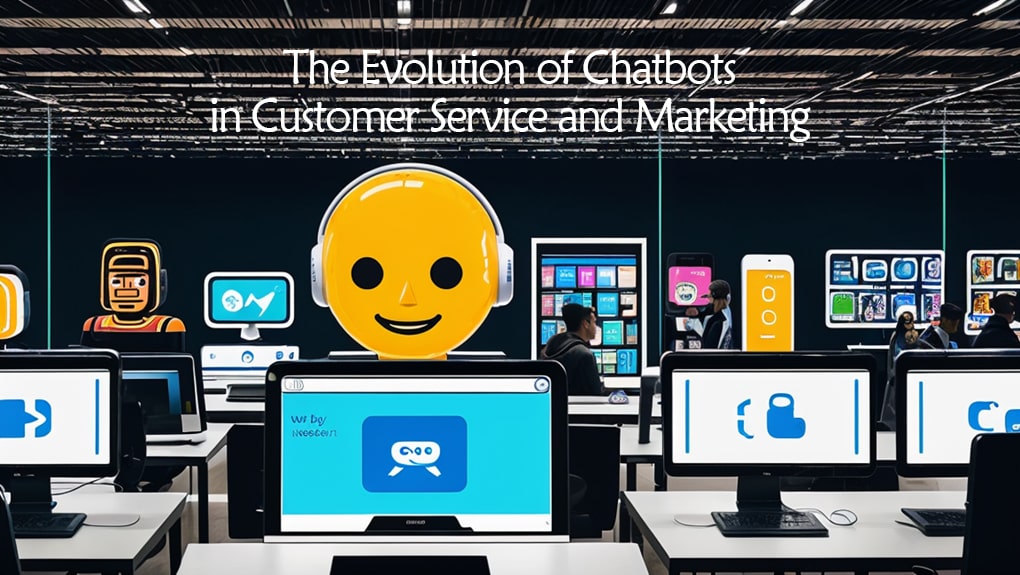|
Getting your Trinity Audio player ready...
|

The landscape of customer service and marketing has undergone a dramatic transformation over the past few decades, driven in large part by advancements in technology. Among the most significant developments in this space is the rise of chatbots. These AI-powered virtual assistants have evolved from simple, rule-based systems to sophisticated conversational agents capable of understanding and responding to complex queries. This article explores the evolution of chatbots in customer service and marketing, analyzing the advancements in chatbot technology and their impact on customer engagement strategies.
Early Days of Chatbots
The Beginnings: Rule-Based Systems
The history of chatbots can be traced back to the mid-20th century with the creation of ELIZA, a program developed by Joseph Weizenbaum in the 1960s. ELIZA used a pattern-matching technique and scripted responses to simulate conversation. Although rudimentary, ELIZA demonstrated the potential of computer programs to engage in human-like interactions.
In the subsequent decades, chatbots remained largely rule-based. These early systems followed predefined scripts and could only handle specific queries within narrow domains. While they provided a glimpse into the future of automated customer service, their limitations were apparent. These bots could not understand context or handle ambiguous requests, often leading to frustrating user experiences.
Transition to AI: Natural Language Processing (NLP)
The turn of the century saw significant advancements in artificial intelligence, particularly in natural language processing (NLP). NLP enables machines to understand, interpret, and generate human language. With the advent of machine learning algorithms, chatbots began to improve in their ability to understand and respond to a broader range of queries.
One notable development during this period was the introduction of AIML (Artificial Intelligence Markup Language), a scripting language that allowed developers to create more sophisticated chatbots. However, these bots were still largely rule-based and lacked the ability to learn from interactions.
The Rise of Machine Learning and AI
Machine Learning Revolution
The real breakthrough in chatbot technology came with the rise of machine learning and deep learning algorithms in the 2010s. Machine learning enabled chatbots to move beyond static scripts and learn from vast amounts of data. This learning capability allowed them to understand context, handle ambiguous queries, and improve over time.
Companies like Google, Microsoft, and IBM began developing advanced NLP models that could process natural language more accurately. Google’s BERT (Bidirectional Encoder Representations from Transformers) and OpenAI’s GPT (Generative Pre-trained Transformer) models are prime examples of how machine learning has transformed chatbots. These models leverage vast datasets to understand the nuances of human language, enabling chatbots to generate more accurate and contextually appropriate responses.
Integration with Messaging Platforms
As chatbots became more sophisticated, they began to integrate with popular messaging platforms like Facebook Messenger, WhatsApp, and Slack. This integration made chatbots more accessible to a broader audience, allowing businesses to engage with customers on platforms they were already using. The ability to deploy chatbots on multiple channels significantly enhanced their reach and utility.
Voice Assistants and Conversational AI
The evolution of chatbots also coincided with the rise of voice assistants like Amazon’s Alexa, Apple’s Siri, and Google Assistant. These voice-activated bots brought conversational AI into the mainstream, enabling users to interact with technology using natural language. Voice assistants demonstrated the potential of chatbots to provide seamless, hands-free interactions, further driving their adoption in customer service and marketing.
Chatbots in Customer Service
Enhancing Customer Support
One of the most significant impacts of chatbots has been in the realm of customer service. Traditional customer support often involved long wait times, repetitive queries, and a lack of personalization. Chatbots have addressed these challenges by providing instant, 24/7 support. They can handle a wide range of queries, from answering FAQs to processing transactions, freeing up human agents to focus on more complex issues.
Personalization and Contextual Understanding
Modern chatbots leverage AI to provide personalized experiences. By analyzing customer data and past interactions, chatbots can offer tailored recommendations and solutions. This level of personalization enhances customer satisfaction and loyalty, as customers feel understood and valued.
Omnichannel Support
With the integration of chatbots across multiple channels, businesses can offer seamless support experiences. Whether a customer reaches out via social media, email, or a website, chatbots can provide consistent and coherent responses. This omnichannel approach ensures that customers receive the same level of support regardless of the platform they choose.
Reducing Operational Costs
Implementing chatbots in customer service also offers significant cost savings. By automating routine tasks, businesses can reduce the need for large support teams. Chatbots can handle a high volume of queries simultaneously, ensuring that customers receive prompt assistance without the need for additional resources.
Chatbots in Marketing
Engaging with Customers
In the realm of marketing, chatbots have become powerful tools for engaging with customers. They can initiate conversations, provide product recommendations, and guide users through the purchasing process. By engaging customers in real-time, chatbots can drive higher conversion rates and boost sales.
Lead Generation and Qualification
Chatbots are also effective in lead generation and qualification. They can engage visitors on a website, gather information about their preferences and needs, and qualify leads based on predefined criteria. This automated process ensures that sales teams receive high-quality leads, improving the efficiency of the sales funnel.
Personalized Marketing Campaigns
Personalization is a key trend in modern marketing, and chatbots play a crucial role in delivering personalized experiences. By analyzing customer data, chatbots can send targeted messages and offers that resonate with individual preferences. This level of personalization increases the effectiveness of marketing campaigns and enhances customer engagement.
Gathering Customer Insights
Chatbots also serve as valuable tools for gathering customer insights. By analyzing conversations and interactions, businesses can gain a deeper understanding of customer needs, preferences, and pain points. These insights can inform marketing strategies, product development, and overall business decisions.
Advancements in Chatbot Technology
Natural Language Understanding (NLU)
One of the critical advancements in chatbot technology is the improvement in natural language understanding (NLU). NLU enables chatbots to comprehend the intent behind user queries, even when phrased in different ways. This capability allows chatbots to provide more accurate and relevant responses, enhancing the overall user experience.
Sentiment Analysis
Sentiment analysis is another significant advancement in chatbot technology. By analyzing the sentiment behind customer messages, chatbots can gauge the emotional tone of interactions. This capability allows them to respond appropriately, offering empathetic and supportive responses when needed. Sentiment analysis enhances the human-like qualities of chatbots, making interactions more natural and engaging.
Multilingual Support
As businesses expand globally, the ability to support multiple languages has become essential. Modern chatbots are equipped with multilingual capabilities, allowing them to engage with customers in their preferred language. This feature enhances accessibility and ensures that businesses can cater to a diverse customer base.
Integration with AI and IoT
The integration of chatbots with artificial intelligence (AI) and the Internet of Things (IoT) has opened up new possibilities for customer service and marketing. AI-powered chatbots can analyze vast amounts of data in real-time, providing insights and recommendations that drive decision-making. When integrated with IoT devices, chatbots can offer proactive support, such as notifying users about maintenance needs or product updates.
Challenges and Considerations
Ensuring Data Privacy and Security
As chatbots handle sensitive customer information, ensuring data privacy and security is paramount. Businesses must implement robust security measures to protect customer data and comply with regulations like GDPR and CCPA. Transparency in data usage and obtaining customer consent are also crucial for building trust.
Balancing Automation and Human Touch
While chatbots offer numerous benefits, striking the right balance between automation and the human touch is essential. There are instances where human intervention is necessary, such as handling complex queries or resolving escalated issues. Businesses must ensure a seamless transition between chatbots and human agents to provide a cohesive customer experience.
Continuous Improvement and Training
Chatbots require continuous improvement and training to remain effective. Regular updates and monitoring are necessary to ensure that chatbots stay current with changing customer needs and preferences. Machine learning models need to be fine-tuned, and new data must be incorporated to enhance performance.
Future Trends in Chatbot Technology
Conversational AI and Contextual Awareness
The future of chatbots lies in the advancement of conversational AI and contextual awareness. Chatbots will become more adept at understanding the context of conversations, allowing them to provide more relevant and accurate responses. This capability will make interactions feel more natural and intuitive, further enhancing customer satisfaction.
Integration with Augmented Reality (AR) and Virtual Reality (VR)
The integration of chatbots with augmented reality (AR) and virtual reality (VR) is an emerging trend. In the context of marketing, AR and VR can create immersive experiences, allowing customers to visualize products in real-time. Chatbots can guide users through these experiences, providing information and recommendations.
Hyper-Personalization
Hyper-personalization involves leveraging advanced analytics and AI to deliver highly tailored experiences. Future chatbots will be able to analyze vast amounts of data, including real-time behavior, to provide hyper-personalized recommendations and offers. This level of personalization will enhance customer engagement and drive loyalty.
Emotional Intelligence
The development of emotionally intelligent chatbots is another exciting trend. By understanding and responding to human emotions, chatbots can provide more empathetic and supportive interactions. This capability will enhance the human-like qualities of chatbots, making them indispensable in customer service and marketing.
In Summary
The evolution of chatbots in customer service and marketing has been nothing short of remarkable. From simple rule-based systems to advanced AI-powered conversational agents, chatbots have transformed the way businesses engage with customers. They offer numerous benefits, including enhanced customer support, personalized experiences, and efficient lead generation.
As technology continues to advance, chatbots will become even more sophisticated, capable of understanding context, emotions, and delivering hyper-personalized experiences. Businesses that leverage these advancements will be well-positioned to provide exceptional customer service and drive successful marketing campaigns. The future of chatbots is bright, and their impact on customer engagement strategies will only continue to grow.




